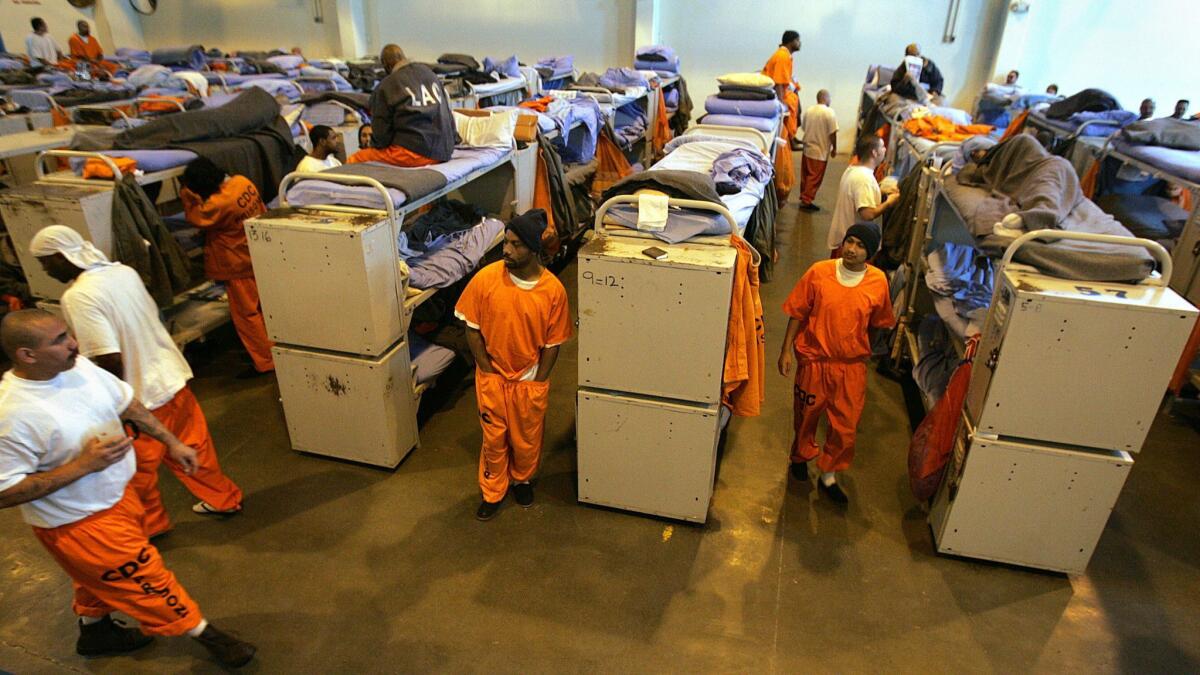California ends its long, costly shift of prisoners to other states

- Share via
For an issue that received so much publicity at its peak — images of prisoners in triple bunk beds and overflowing into multipurpose rooms — the end of California’s prison crisis came quietly last week, when the state brought home the last of its inmates held in a private lockup northwest of Tucson.
Making good on a pledge by Gov. Gavin Newsom to finish the process begun in 2012, state prison officials have wrapped up the contracts with all out-of-state prisons. California’s prison overcrowding problems are now a thing of the past.
“At one point, at the height of our overcrowding, we had nearly 10,400 inmates out of state,” said Ralph Diaz, secretary of the California Department of Corrections and Rehabilitation. “To me, that meant 10,400 inmates away from their families, away from California. It was just a place we didn’t want to be.”
Gov. Gavin Newsom has signed his first budget. Here’s where the $215 billion will go »
The use of private prisons — six facilities in states as far away as Mississippi — began in 2006. Inmates were shuttled away at various intervals over the 13 years that followed, a cost that was unavoidable to help resolve a problem that was years in the making.
Lawsuits challenging conditions inside California’s crowded prisons resulted in a fixed cap on the inmate population, one imposed by federal judges in 2009 and upheld by the U.S. Supreme Court in 2011 and again in 2013. Those decisions came in the wake of a 2006 announcement that outside experts would run the state’s prison healthcare system. Some of that independent oversight continues, though the state has made strides to resume control of health services.
Prison spending in the state’s new fiscal year will total some $15.7 billion — a $2.6-billion increase in the last four years and only slightly lower, by percentage, than what the budget earmarks for colleges and universities.
How the inmate population came down, though, is a story of criminal justice programs that sought to limit prison time to those convicted of the most serious and violent felonies. In the year before a major realignment of criminal justice services to California’s counties, 58% of new prison sentences were for property or drug crimes.
But the changes that shifted many of those crimes away from prison — keeping more offenders in local jails, reducing penalties for property crimes and a sweeping expansion of parole — have not come without controversy. Critics have said too many lower-level offenders have been responsible for new crimes. And a vocal coalition of victim advocates drafted a plan for voters to change those parole rules through a measure that has qualified for the November 2020 ballot.
State prison officials said last week the total population across 34 facilities now stands at just under 126,000 inmates — below the maximum number allowed by the courts. But the room for growth is not sizable enough to return to the era of long prison sentences, a shift that would require the state to do something almost unheard of in recent years: build more prisons.
Nor will it be as cheap to house those inmates in California. Corrections officials said it cost an average of $31,106 per inmate sent out of state last year — but those in state cost an average of $82,910 a year.
Still, the end of the out-of-state transfers marks an important moment. Diaz, who was appointed by the governor in March to run the prison system, said it sends an important message about accountability.
“It feels a lot better when I’m able to pick up the phone and send someone directly within a day to a prison under my care,” he said.
Follow @johnmyers on Twitter and sign up for our daily Essential Politics newsletter
More to Read
Get the L.A. Times Politics newsletter
Deeply reported insights into legislation, politics and policy from Sacramento, Washington and beyond. In your inbox twice per week.
You may occasionally receive promotional content from the Los Angeles Times.











